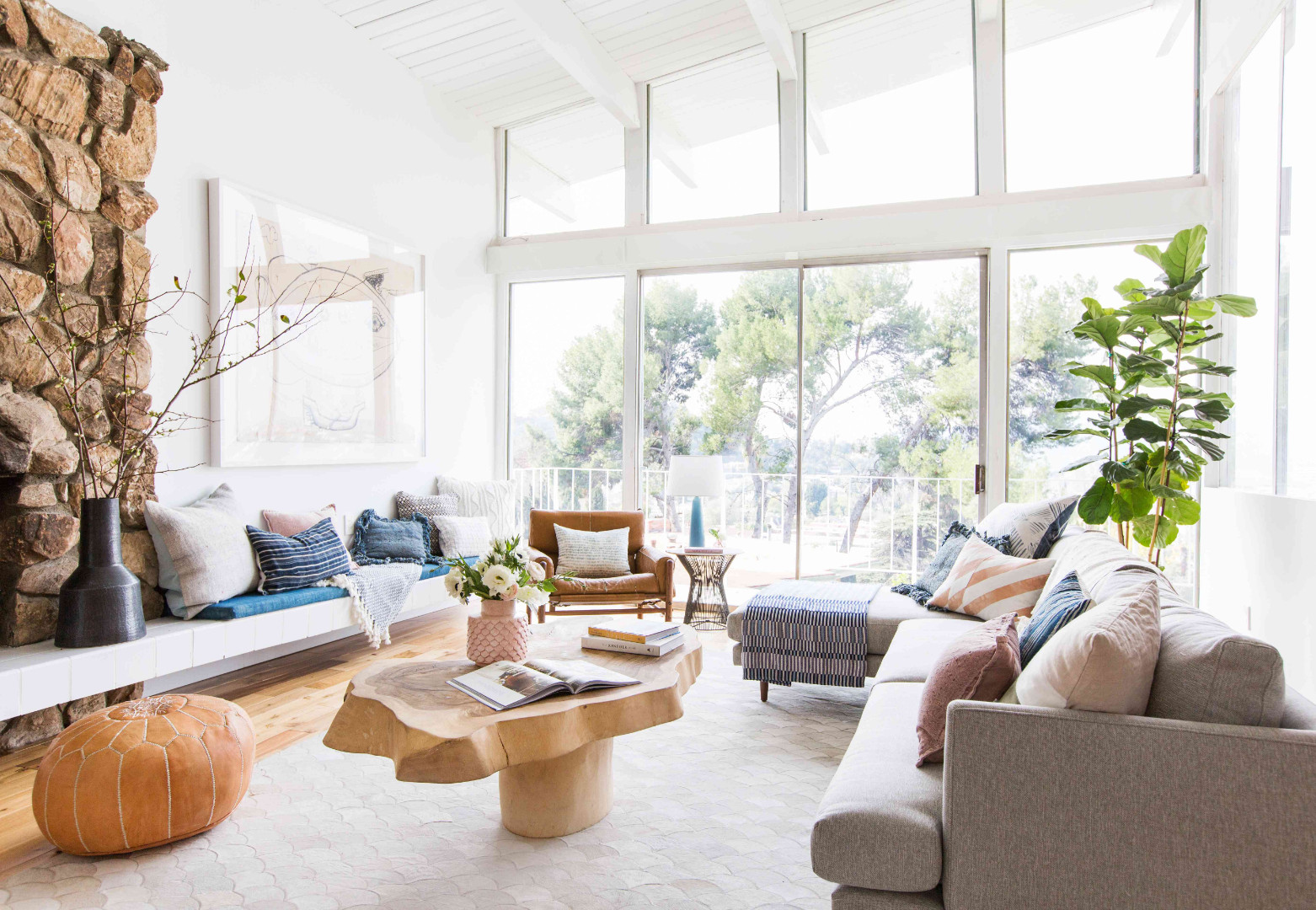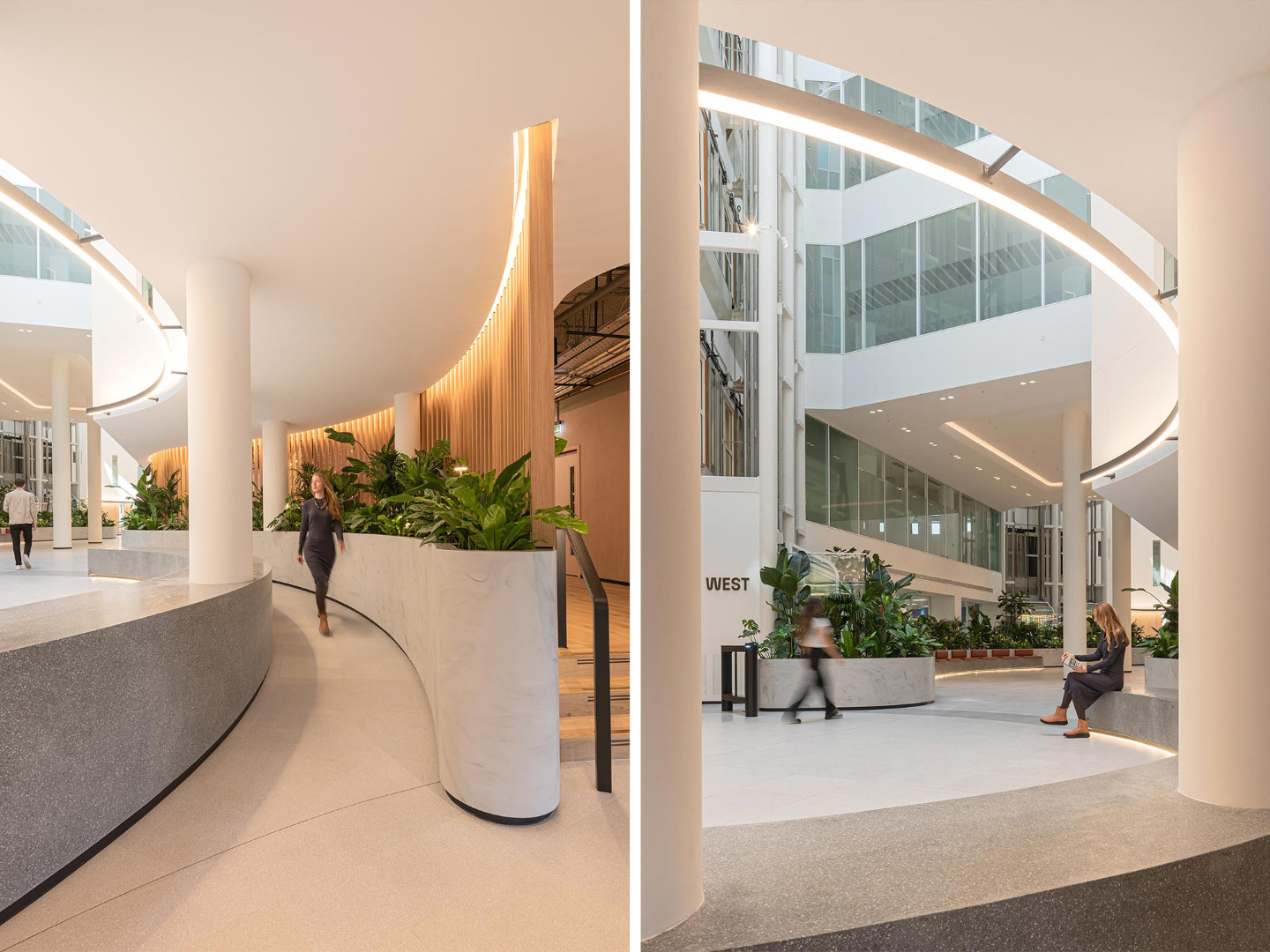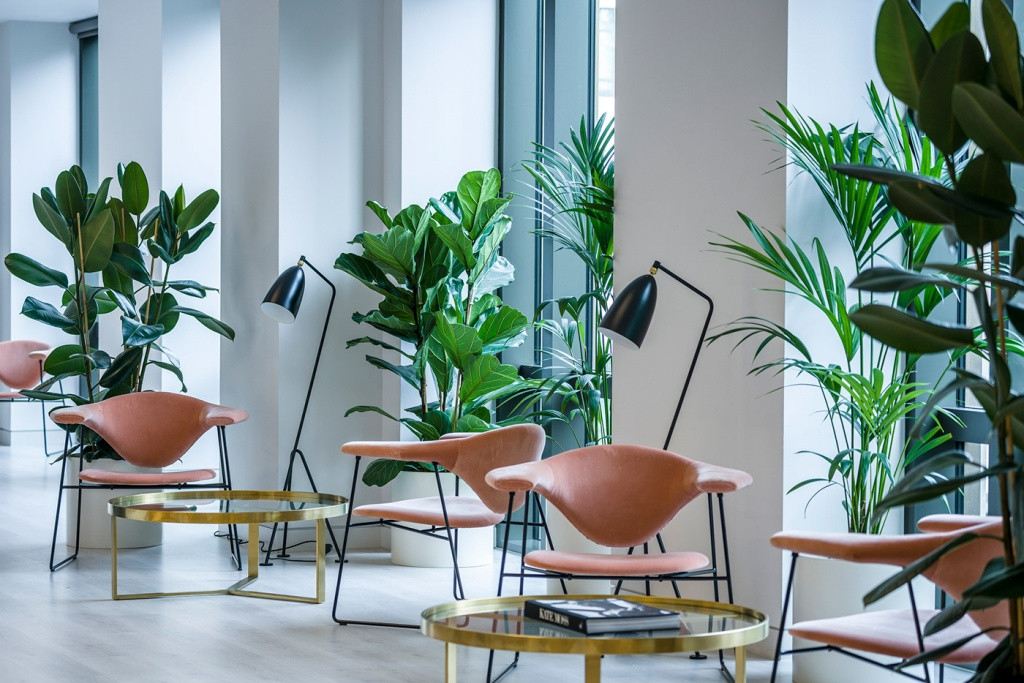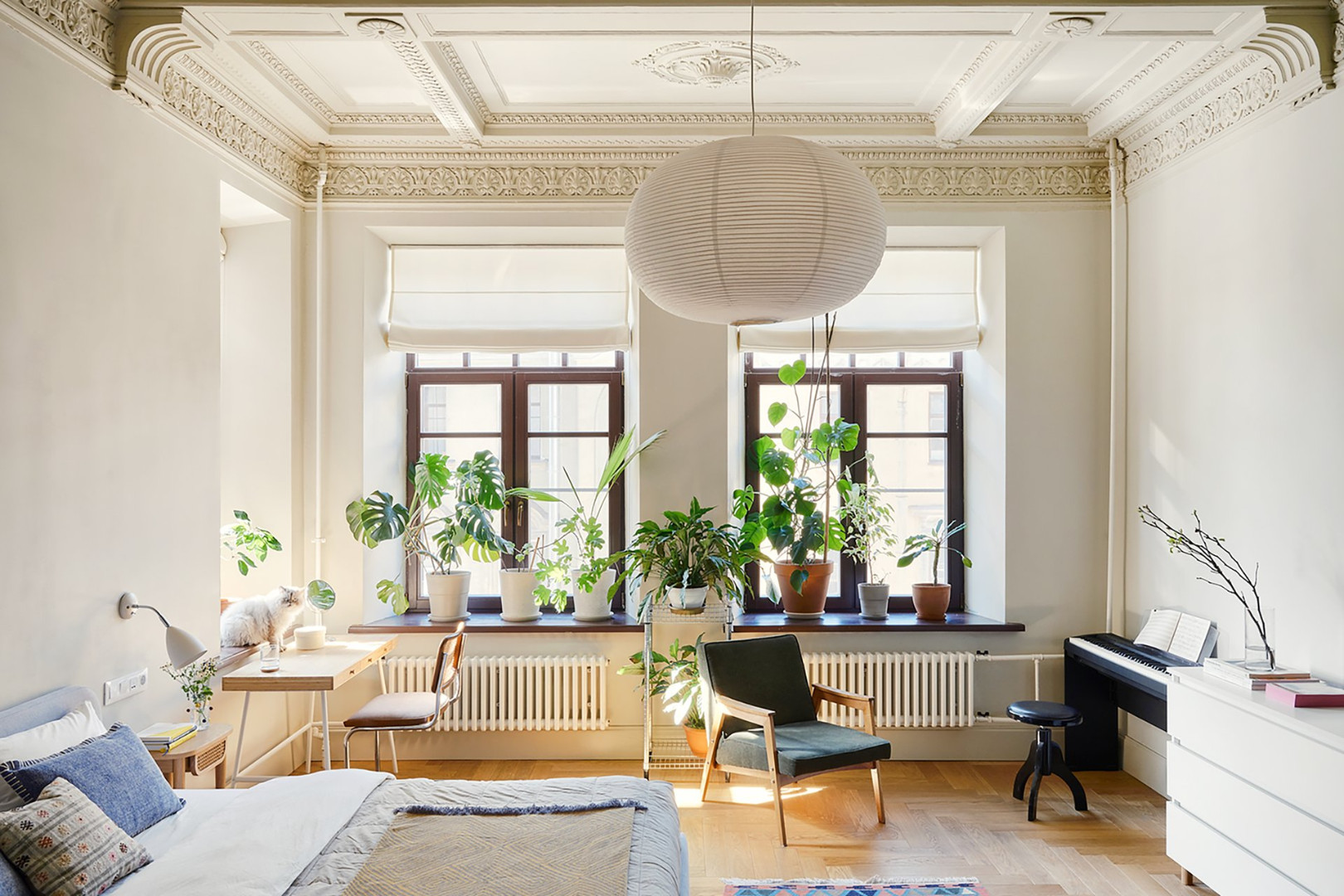Modern organic style in interior design — is a harmonious fusion of natural elements with the clean aesthetics of minimalism. This approach to space design creates cozy yet elegant interiors where each element has its place and purpose. Imagine a space where you involuntarily take a deep breath and your shoulders relax — that's what organic modern is. In this article, we will explore the basic principles of this style, its distinctive features, and ways to implement it in your home.
What is Organic Modern: Basic Principles and Philosophy
 Organic modern as a direction in interior design represents an evolution of classic minimalism, supplemented with elements of nature and eco-friendliness. It's a style that combines geometric rigor of forms with organic lines and textures, creating spaces filled with tranquility and harmony.
Organic modern as a direction in interior design represents an evolution of classic minimalism, supplemented with elements of nature and eco-friendliness. It's a style that combines geometric rigor of forms with organic lines and textures, creating spaces filled with tranquility and harmony.
Biophilic design, which underlies organic modern, is based on our innate need for contact with nature. Research shows that interiors incorporating natural elements help reduce stress, increase productivity, and improve overall well-being according to design experts.
"Organic modern is not just a design trend, but a philosophy of creating a space that supports human well-being through the integration of natural elements into modern architecture. It's a return to origins while maintaining modern functionality," — notes renowned interior designer Kelly Wearstler.
History and Evolution of Organic Modern Style
 The roots of organic modern can be traced in the works of mid-20th century architects such as Frank Lloyd Wright and Alvar Aalto, who sought to create buildings that harmoniously blend into the surrounding landscape. However, the modern organic style has undergone significant evolution, incorporating elements of Scandinavian design, Japanese minimalism, and contemporary eco-friendly trends.
The roots of organic modern can be traced in the works of mid-20th century architects such as Frank Lloyd Wright and Alvar Aalto, who sought to create buildings that harmoniously blend into the surrounding landscape. However, the modern organic style has undergone significant evolution, incorporating elements of Scandinavian design, Japanese minimalism, and contemporary eco-friendly trends.
The influence of Japanese minimalism on organic modern is particularly noticeable in the wabi-sabi philosophy, which values imperfection, simplicity, and naturalness. In simple terms, wabi-sabi – is finding beauty in imperfection: how an old wooden table with wear and scratches can look much more interesting and "alive" than a new glossy one. This approach resonates with the principles of organic modern, where the beauty of natural materials and textures becomes the central element of design.
Natural Materials in Organic Modern Interiors
 The choice of materials plays a key role in creating an organic modern style interior. Preference is given to natural, environmentally friendly materials that bring warmth and authenticity to the space. Touch unprocessed wood, feel the coolness of natural stone under your fingers — these tactile sensations create a unique sense of connection with nature that cannot be imitated by artificial materials.
The choice of materials plays a key role in creating an organic modern style interior. Preference is given to natural, environmentally friendly materials that bring warmth and authenticity to the space. Touch unprocessed wood, feel the coolness of natural stone under your fingers — these tactile sensations create a unique sense of connection with nature that cannot be imitated by artificial materials.
Let's consider the main natural materials used in organic modern and their key characteristics.
| Material | Application in Interior | Features |
|---|---|---|
| Wood | Furniture, flooring, wall finishing | Creates a warm atmosphere, each species has a unique texture |
| Stone | Countertops, decorative elements, cladding | Adds strength and durability, natural textures and tones |
| Linen and cotton | Textiles, furniture upholstery | Natural fibers, pleasant to touch, eco-friendliness |
| Rattan and bamboo | Furniture, decorative elements | Lightness, durability, exotic appearance |
| Ceramics | Tableware, decorative accessories | Handmade, uniqueness of each item |
| Burl wood | Accent furniture pieces, decor | Unique wood pattern, luxurious appearance |
The selection of these materials in interior design not only creates visual appeal but also contributes to creating a healthy microclimate in the space. In 2025, products made from burl wood gained particular popularity, with sales increasing by 420%, indicating a growing interest in unique natural textures in interior design.
The selection of these materials in interior design not only creates visual appeal but also contributes to creating a healthy microclimate in the space. In 2025, products made from burl wood gained particular popularity, with sales increasing by 420%, indicating a growing interest in unique natural textures in interior design.
Color Palette and Textures in Organic Modern
The color palette of the organic style is based on natural shades and neutral tones. This doesn't mean the interior should be monochromatic — on the contrary, the variety of natural textures and tones creates visual interest and depth of space.
Pastel natural shades such as sand, olive, terracotta often serve as the basis for the color scheme. Contrasting accents can be added through rich colors found in nature: deep greens, earthy browns, or rich blue tones.
Natural textures in design play an equally important role as color. The roughness of unprocessed stone, the warmth of wooden surfaces, the softness of natural fabrics — all these tactile elements create multi-layered depth in organic modern style interiors.
How to Create an Organic Modern Interior
 Creating an organic modern style interior begins with thoughtful space planning. Eco-friendly minimalism implies the absence of visual noise and excess elements, while each item should be functional and aesthetically pleasing.
Creating an organic modern style interior begins with thoughtful space planning. Eco-friendly minimalism implies the absence of visual noise and excess elements, while each item should be functional and aesthetically pleasing.
Space and Light in Organic Modern
Natural lighting plays a key role in organic modern interiors. Imagine how morning light penetrates through minimal curtains, creating soft shadows and highlighting the textures of natural materials — this is magic that even the most sophisticated artificial lighting cannot replace. Large windows, minimal curtains, light walls — all this contributes to maximum penetration of daylight into the room. In the evening, preference is given to soft, diffused lighting that creates a cozy atmosphere.
Space planning should be functional and balanced. Organic forms in organic modern interiors soften the strict geometry of minimalism, creating smooth transitions between zones.
Furniture and Decorative Elements
Wooden furniture in minimalist style is the foundation of organic modern interiors. Preference is given to simple, functional forms with minimal decorative elements. However, this does not mean a lack of individuality — unique items with characteristic natural textures can become interior accents.
"In my practice, I observe how organic modern transforms living spaces, making them more harmonious and comfortable. The key to success — is in the details: properly selected materials, lighting, and proportions create a balance between aesthetics and functionality," — shares designer Sarah Sherman Samuel.
Decor from natural materials should be minimalist but thoughtful. Eco-friendly decorative items such as handmade ceramic vases, wooden sculptures, or textile products from natural fibers add individuality and warmth to the interior.
Plants in Organic Modern Interiors
 Plants are an integral element of organic modern, bringing living energy and connection with nature into the interior. Remember that feeling of peace that engulfs you in a forest or park? This is exactly what biophilia tries to recreate in architecture and interior design, integrating greenery as structural elements of space.
Plants are an integral element of organic modern, bringing living energy and connection with nature into the interior. Remember that feeling of peace that engulfs you in a forest or park? This is exactly what biophilia tries to recreate in architecture and interior design, integrating greenery as structural elements of space.
The choice of plants depends on the characteristics of the room and personal preferences. Sculptural plants with clear forms look good in a minimalist interior: ficus trees, succulents, dracaenas. To create a softer, organic image, ferns, ivies, or plants with airy foliage would be suitable.
Success Story: House Renovation in Dallas
In 2024, a house renovation project in organic modern style was implemented in Dallas, which became a vivid example of the successful embodiment of this direction's principles in a real interior. Designer Joshua Rice developed a project for a young couple who wanted to create a modern yet cozy space.
The basis of the interior was natural materials: walnut wood floors, limestone countertops, linen curtains, and cotton textiles. The designer skillfully combined modern furniture lines with warm, natural textures. Vintage furniture played a special role in the project, adding uniqueness and character to the interior.
The project received numerous positive reviews and was published in leading design publications as an example of organic modern that combines functionality, aesthetics, and eco-friendliness. The success of this project demonstrates how organic modern can be adapted to individual needs and preferences of owners, creating a truly harmonious living space.
"Working on the project in Dallas, we sought to create a balance between contemporary aesthetics and natural elements. Organic modern allows us to develop spaces that feel simultaneously fresh and timeless, minimalist and full of character. The key was to find the right ratio of textures and materials," — Joshua Rice talks about his project.
Economic Aspects and Sustainability
Organic modern is not only aesthetically pleasing but also economically justified. According to a Zillow report, designing an interior in organic modern style can increase property value by up to 3.7%. This is related to the growing interest of buyers in environmentally friendly, sustainable interior solutions.
Sustainable interior design is becoming an increasingly important factor in housing selection, especially among millennials. About 43% of this generation prefer eco-friendly design, including the use of recycled materials and natural textures.
The global interior design market, according to experts, reached $134.22 billion in 2023 and continues to grow. It is expected to reach $175.74 billion by 2030 with an annual growth of 4.1%. A significant part of this growth is driven by interest in eco-friendly, sustainable solutions, including organic modern, as shown by a comprehensive review of research in the field of sustainable interior design.
Differences Between Organic Modern and Other Styles
To better understand organic modern, it's useful to compare it with related styles in interior design. Although they have common features, each style has its unique characteristics.
For a deeper understanding of organic modern's place in contemporary design, we offer a comparative table of main styles that have similar elements.
| Style | Characteristics | Differences from Organic Modern |
|---|---|---|
| Organic Modern | Combination of nature and minimalism, natural materials, clean lines | Balance between warmth of natural materials and contemporary aesthetics |
| Bionic Design | Imitation of natural forms and structures, innovative materials | More technological, focus on form and function, often more futuristic |
| Scandinavian Style | Light colors, natural materials, functionality | More strict and lighter, less diverse in textures |
| Eco-Style | Emphasis on ecology and sustainability, recycled materials | Less focused on minimalist aesthetics, more attention paid to nature conservation |
| Japanese Minimalism | Principles of wabi-sabi, simplicity, functionality | More ascetic, less variety in textures and materials |
This comparison helps to see that organic modern occupies a unique niche in interior design, combining the warmth of natural elements with the cleanliness and functionality of contemporary minimalism. It can be viewed as a softer, more humanistic version of classic minimalism or as a more contemporary interpretation of eco-friendly design.
This comparison helps to see that organic modern occupies a unique niche in interior design, combining the warmth of natural elements with the cleanliness and functionality of contemporary minimalism. It can be viewed as a softer, more humanistic version of classic minimalism or as a more contemporary interpretation of eco-friendly design.
Practical Advice and Common Mistakes in Organic Modern Style
 Even with an understanding of the general philosophy of the style, it's important to consider nuances — they determine whether the interior will become truly organic or remain merely a stylization.
Even with an understanding of the general philosophy of the style, it's important to consider nuances — they determine whether the interior will become truly organic or remain merely a stylization.
3 Typical Mistakes When Creating an Organic Modern Interior
When trying to implement organic modern in interiors independently, many make the following mistakes that can turn potentially harmonious space into visual chaos:
- Overloading with natural textures. Imagine a room where rough stone, unprocessed wood, woven furniture, linen textiles, ceramics, and leather coexist simultaneously — eyes literally have nowhere to rest! Solution: choose 2-3 dominant textures, use the rest as accents.
- Ignoring the balance between minimalism and natural elements. Too much decor turns the interior into eco-style, too little – into cold minimalism. Solution: follow the rule "less, but better quality".
- Poorly planned lighting. It's disappointing to see how beautifully selected natural materials lose all their beauty in inappropriate light. Organic modern requires soft, multi-level lighting. Solution: combine natural light with several sources of artificial light, use lamps made from natural materials.
Organic modern requires fine-tuning — and it is attention to balance, light, and moderation that transforms the style into a living, harmonious space, not a set of random natural elements.
5 Ready-Made Color Schemes for Different Rooms
Selecting the right color palette – is an important step in creating a harmonious interior. Here are some proven combinations for different rooms:
| Room | Main Colors | Accent Colors |
|---|---|---|
| Living Room | Warm gray, cream, white | Olive, terracotta, umber |
| Bedroom | Sand, light blue, ecru | Muted blue, pale green |
| Kitchen | Natural wood, white, light gray | Sage green, ochre |
| Bathroom | Light stone, white, beige | Sea blue, gray-green |
| Home Office | Dark wood, cream, gray | Graphite, bottle green |
These color schemes can be adapted to your space and lighting. The main rule – is to choose shades found in nature and avoid too bright, neon tones.
Checklist: Creating an Organic Modern Interior
Step-by-step plan for creating an organic modern style interior with an approximate budget allocation:
- Planning (5% of budget)
- Identify key zones and their functionality
- Create a mood board with organic modern references
- Choose a color palette
- Basic Work (35% of budget)
- Wall finishing with neutral colors (paint or plaster)
- Installation of flooring from natural materials
- Update ceiling and lighting system
- Furniture (40% of budget)
- Purchase main furniture items with clean lines and from natural materials
- Organic arrangement considering functional zones
- Textiles (10% of budget)
- Selection of curtains, pillows, rugs from natural materials
- Combination of various textures to create depth
- Lighting (5% of budget)
- Installation of multi-level lighting
- Selection of lamps made from wood, stone, ceramics
- Plants and Decor (5% of budget)
- Selection of plants considering room conditions
- Choice of few but quality decorative elements
And remember: organic modern — is not just a style, but a way to feel at home, in a space that breathes with you.
Adapting Organic Modern in a Rented Apartment
 If you live in rented housing but want to create an organic modern style interior, use the following approaches:
If you live in rented housing but want to create an organic modern style interior, use the following approaches:
- Focus on mobile elements: furniture, textiles, lighting
- Use removable wall stickers with nature motifs
- Create mobile "green islands" from plants in beautiful planters
- Compensate for the lack of natural materials in finishing through furniture and accessories
- Experiment with light: use floor and table lamps to create the desired atmosphere
Even in a rented apartment, organic modern can manifest in all its power — just start with details that make the space truly yours.
Conclusion
Organic modern represents not just a fashionable trend in interior design but a deep philosophy of creating spaces that meet the needs of modern humans for comfort, harmony, and connection with nature. The combination of nature and minimalism in interiors allows for creating balanced, calm spaces that serve as the perfect background for everyday life.
Imagine returning home after a tense day and stepping over the threshold of a space where every element evokes an involuntary sigh of relief. The textures of natural wood under your fingers, soft light reflecting off natural surfaces, fresh air and a sense of spaciousness — this is what an organic modern style interior gives. Isn't this what we all crave in our information-overloaded world?
The popularity of this style continues to grow, as evidenced by the increase in search queries and volumes of the interior design market. According to Houzz, in 2024, search queries for "organic modern bedroom" increased by 245% compared to the previous year.
Implementing organic modern principles in your interior — is an investment not only in the aesthetics of your home but also in your well-being and quality of life. It's a path to creating a space that reflects your values and aspiration for harmony with the surrounding world.

